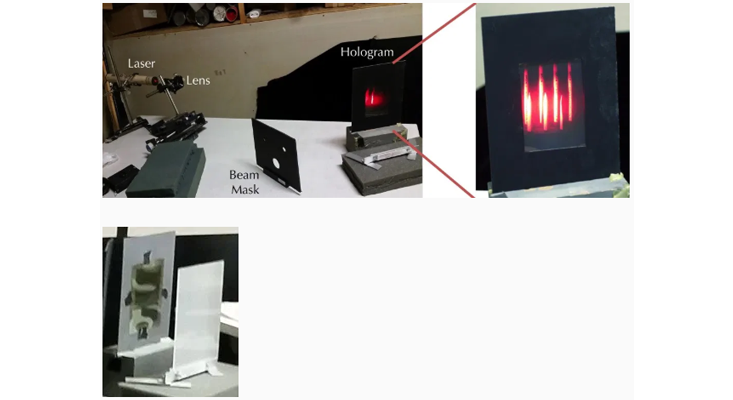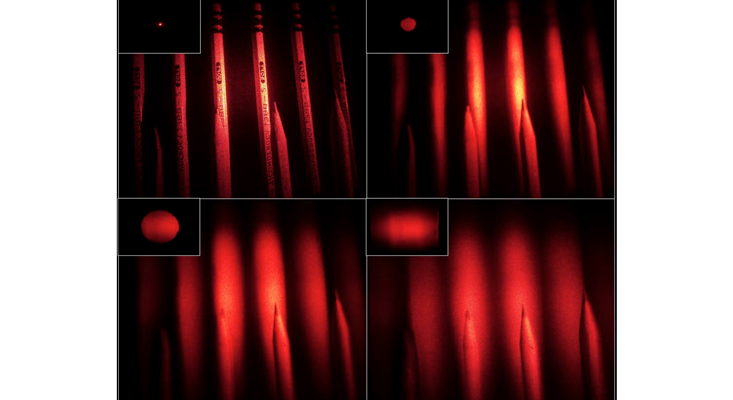I remember buying my first hologram as a college student in the mid-1980s. It showed a bed of nails. I came across it at a gallery in what was then the world’s capital of spacey trinkets, Haight Street in San Francisco. When I picked it up, the hologram looked like a featureless sheet of film, but when I held it under the right lighting at the right angle, the nails popped out aggressively. The hologram never failed to get a shocked reaction from people. It worked because the image of the nails was smeared across the entire film, so that it would be reconstituted in slightly different ways from different viewing angles, evoking a sense of depth.
In the early ’90s theoretical physicists came up with the idea of the holographic principle, which suggests that the world around us is also a kind of holographic projection. The 3-D space we experience might be generated by a two-dimensional reality or even a zero-dimensional system, one that cannot be thought of as residing in space at all. This radical proposition came out of the study of black holes and the quantum effervescence at their perimeter, or event horizon. A black hole looks like a volume of space with lots of room to hold stuff, but its capacity doesn’t scale up as a volume should. If you try to fill it up, you find yourself strangely unable to do so—just as when you went to touch the nails in my hologram, you felt only empty air, betraying the illusion.
Are holograms just a convenient metaphor, or could looking at a real hologram help us grasp the abstract principle?
The holographic principle has been an enormously fertile idea and physicists have spent the past two decades refining and extending it. Through it, they have found unexpected connections between the structure of spacetime and quantum computing. A hologram stores an image in a redundant way, like the error-correction codes that maintain the integrity of data.
One of those who developed the idea, Leonard Susskind, tells me he took his inspiration from a hologram that he and several colleagues passed in a hallway at Stanford: “We jokingly said, ‘Maybe the horizon is like a hologram.’ It was a joke and not a joke.” But I got to wondering: Are holograms just a convenient metaphor, or could looking at a real hologram help us grasp the abstract principle? So I visited a leading hologram-maker, John Perry, at his studio in Burlington, Vermont. He did a demonstration of how a holographic projection gradually unfurls, mimicking how a dimension of space might emerge from a deeper reality.
Perry used a hologram of pencils—a front row of pencil tips and a back row of pencil erasers—illuminated by a red laser beam. First he showed how he normally positions the hologram and lighting. The image appeared behind the film, as though you had to reach through the film to touch the pencils.

Then Perry flipped the hologram around to make the image appear in front, and he placed a plastic screen a certain distance away (see photograph at right). That way, we could selectively view only a single plane of the image, taking a slice through the projection to reveal how it was structured. You could tell that the hologram was reversed because the lettering on the pencils, “Ticonderoga,” was mirror-imaged.
With this setup, we could see the effect of illuminating only part of the hologram. We started by aiming the raw laser beam at the film, for just a pinprick of light. If you shone such a narrow shaft of light on a standard photograph, you’d see just one tiny part of the scene; the rest would lie in darkness. On a hologram, though, even partial illumination shows the entire scene. Each part contains the whole. On a photo, the mapping between film and image is local: Each spot of the film corresponds to a specific part of the scene. But on a hologram the mapping is nonlocal. The pencil tips and erasers lie right on top of each other on the film, but are located at separated locations in the 3-D projection.
What we lost with the narrow illumination was a sense of depth. The whole scene was in focus, so that the pencil tips and erasers appeared to be located at the same distance from the viewer. The third dimension had not yet emerged. Using a lens and cardboard mask, Perry gradually enlarged the beam. The pencil tips remained in focus, but the erasers got blurrier. Illuminating a wider area of the film allowed the scene to be viewed from an increasing range of perspectives. The projection was developing some depth.

These same principles apply to the holographic principle in fundamental physics. The mapping between our 3-D universe and the putative 2-D reality is also highly nonlocal. Your body spans a limited volume of 3-D space, but is spread over the full width of the lower-dimensional system. Where the hologram metaphor fails is that there is no laser or projector. The holographic image does not fill space. It is space. The 2-D system behaves as if a third dimension were tucked inside it like a figure in a pop-up book.
Although theorists originally conceived of the holographic principle as a static equivalence between higher- and lower-dimensional realms, some think it might be a dynamic process. The 2-D system might begin in a disordered state, lacking coordination among its different components. Like Perry’s partly illuminated hologram, it does not evoke a third dimension. Gradually the system becomes ordered, as if the hologram were being illuminated over a wider area, so that the third dimension rolls out. That may be how space emerged at the big bang and, in reverse, how it submerges in a black hole.
Above all, a hologram is an amazing thing. Whether nails, pencils, or galaxies, it makes you go “Whoa.” And that is exactly the reaction physicists want you to have when space materializes from spacelessness.
George Musser is an award-winning science writer and the author of Spooky Action at a Distance and The Compete Idiot’s Guide to String Theory. Follow him at @gmusser






























